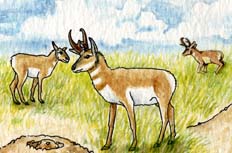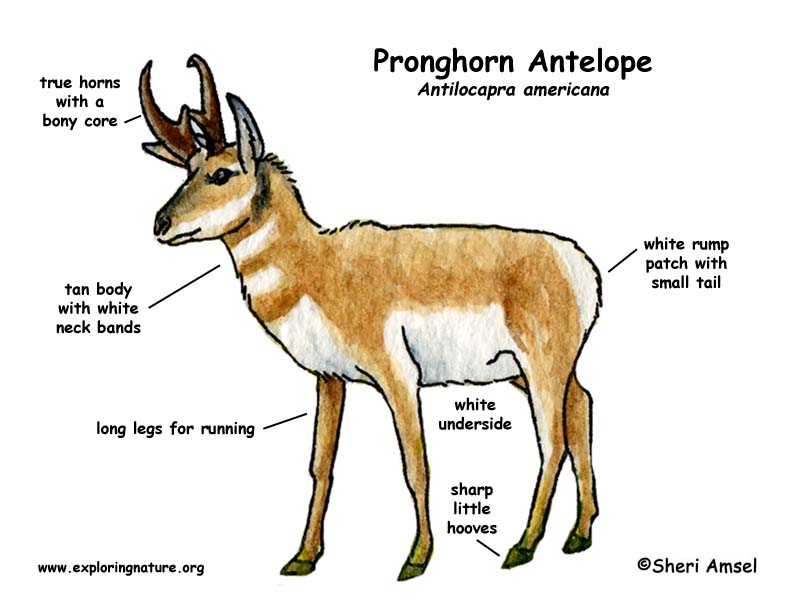

Pronghorn antelopes are found only in one place in the whole world -- the American west.
They live out on the grasslands, liking the shorter grass prairies where they can use their excellent vision to watch for predators. They are also found in dry (arid) scrublands.
They are tan to brown colored with a lighter belly and rump and light tan rings around their necks. Both males and females have horns (the females are much smaller). Horns are different than the antlers of deer and moose. Pronghorns are the only animals in the world who lose their horns every year. The outer covering (sheath) of the horn falls off every fall and then grows back by the next summer. Males can grow to weigh more than 150 pounds. Females rarely weigh more than 100 pounds.
Pronghorns are considered the fastest animal in the whole western hemisphere reaching speeds of 60 mph.
Pronghorns are herbivores, eating mostly plants, shrubs (like sagebrush) and some cactus and grass.
Predators include coyote, grizzly (in Yellowstone Park), and man.
In the fall, territorial males compete for females to mate with, sometimes fighting aggressively. Winning males collect harems of many females (does). Females are pregnant for about 8.5 months (gestation) having 1-2 young in late May to early June. Pronghorn antelopes have twins a little more than they have single babies.
They can live 7 to 10 years in the wild. They are listed as Lower Risk - least concern.
Kingdom: Animalia
Phylum: Chordata
Subphylum: Vertebrata
Class: Mammalia
Order: Artiodactyla
Family: Antilocapridae
Genus: Antilocapra
Species: Antilocapra americana
When you research information you must cite the reference. Citing for websites is different from citing from books, magazines and periodicals. The style of citing shown here is from the MLA Style Citations (Modern Language Association).
When citing a WEBSITE the general format is as follows.
Author Last Name, First Name(s). "Title: Subtitle of Part of Web Page, if appropriate." Title: Subtitle: Section of Page if appropriate. Sponsoring/Publishing Agency, If Given. Additional significant descriptive information. Date of Electronic Publication or other Date, such as Last Updated. Day Month Year of access < URL >.
Amsel, Sheri. "Antelope (Pronghorn)" Exploring Nature Educational Resource ©2005-2024. December 13, 2024
< http://exploringnature.org/db/view/Antelope-Pronghorn >

